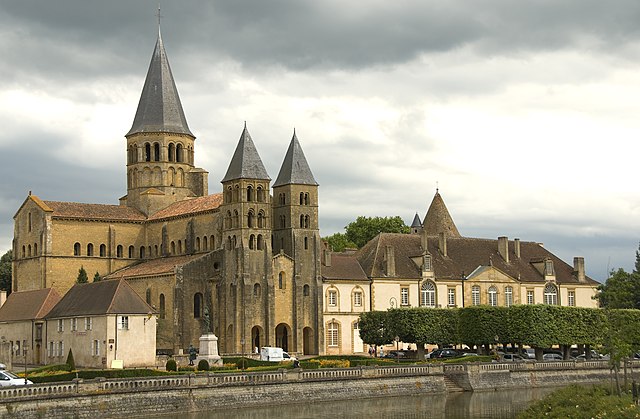Basilica of the Sacred Heart of Paray-le-Monial
From Wikipedia, the free encyclopedia
The Basilica of the Sacred Heart of Paray-le-Monial (French: Basilique du Sacré-Cœur, pronounced [sakʁe kœʁ]), commonly known as Basilica of Paray-le-Monial, is a Romanesque Catholic church dedicated to the Sacred Heart of Jesus in Paray-le-Monial, Bourgogne-Franche-Comté, France.[1]

History
The basilica is a popular landmark and one of the most visited religious site in the country. The Sacred Heart became a popular worldwide devotion in large part due to the visions of Margaret Mary Alacoque, who lived and died at the monastery next to the basilica.[2]
The church was built in the 12th century by Hugues de Semur, the most important of the Abbots of Cluny, on the site of a 10th-century monastery founded by count Lambert of Chalon. It was a small-scale version of the Abbey of Cluny. It was completed in the 14th century, although some sections were added in the 18th century or renovated in the 19th century. As a priory, it was under the authority of Cluny and was a popular pilgrimage site. It is the best conserved example of Cluniac architecture in Burgundy.[3]
Description


The church has a rather short nave and two aisles, crossed by a single-nave transept. The choir includes a semicircular apse with an ambulatory, and three radial chapels. The edifice has an overall length of 63.5 meters, including the vestibule and the eastern chapel, and a width of 22.35 m. The nave (which is 22 m tall) and the aisles are covered by ogival barrel vaults, with, internally, the use of different height levels which was typical of Romanesque architecture. It has pre-Gothic pillars, a blind tribune and a clerestory with small windows. The capitals of the columns are generally decorated with vegetable motifs, although some feature depictions of animals or other figures. The choir houses a 14th-century fresco, rediscovered in 1935.
The exterior has a sober appearance, with massive walls. The few decorations include the portal of the transept's left arm, with flower and geometrical motifs. The crossing is surmounted by a tower with an elevation of 56 m; two smaller towers are also at the sides of the main facade.
The complex include other buildings, such as an 18th-century cloister.
References
Sources
External links
Wikiwand in your browser!
Seamless Wikipedia browsing. On steroids.
Every time you click a link to Wikipedia, Wiktionary or Wikiquote in your browser's search results, it will show the modern Wikiwand interface.
Wikiwand extension is a five stars, simple, with minimum permission required to keep your browsing private, safe and transparent.
